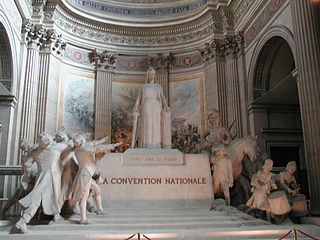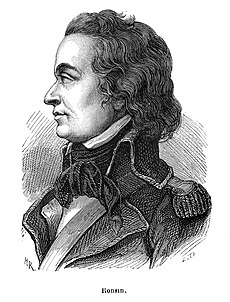
Bertrand Barère de Vieuzac was a French politician, freemason, journalist, and one of the most prominent members of the National Convention during the French Revolution.

The Society of the Friends of the Constitution, after 1792 renamed Society of the Jacobins, Friends of Freedom and Equality, commonly known as the Jacobin Club or simply the Jacobins, became the most influential political club during the French Revolution of 1789 and following. The period of their political ascendency is known as the Reign of Terror, during which time tens of thousands were put on trial and executed in France, many for political crimes.

The National Convention was the first government of the French Revolution, following the two-year National Constituent Assembly and the one-year Legislative Assembly. Created after the great insurrection of 10 August 1792, it was the first French government organized as a republic, abandoning the monarchy altogether. The Convention sat as a single-chamber assembly from 20 September 1792 to 26 October 1795.

Jacques-Nicolas Billaud-Varenne, also known as Jean Nicolas, was a French personality of the Revolutionary period. Though not one of the most well known figures of the French Revolution, Jacques Nicolas Billaud-Varenne was an instrumental figure of the period known as the Reign of Terror. Billaud-Varenne climbed his way up the ladder of power during the period of The Terror, becoming one of the most militant members of the Committee of Public Safety. He was recognized and worked with French Revolution figures Georges Danton and Maximilien Robespierre, and is often considered one of the key architects of the period known as The Terror. "No, we will not step backward, our zeal will only be smothered in the tomb; either the Revolution will triumph or we will all die."

Jean-Lambert Tallien was a French political figure of the revolutionary period.

Jean-Baptiste Robert Lindet was a French politician of the Revolutionary period. His brother, Robert Thomas Lindet, became a constitutional bishop and member of the National Convention. Although his role may not have been spectacular, Jean-Baptiste Lindet came to be the embodiment of the growing middle class that came to dominate French politics during the Revolution.

Jacques René Hébert was a French journalist, and the founder and editor of the extreme radical newspaper Le Père Duchesne during the French Revolution. He was a leader of the French Revolution and had thousands of followers as the Hébertists ; he himself is sometimes called Père Duchesne, after his newspaper.

The Law of 22 Prairial, also known as the loi de la Grande Terreur, the law of the Great Terror, was enacted on 10 June 1794. It was proposed by Georges Auguste Couthon but seems to be written by Robespierre according to Laurent Lecointre. By means of this law the Committee of Public Safety simplified the judicial process to one of indictment and prosecution.

Marc-Guillaume Alexis Vadier was a French politician of the French Revolution.

Jean-Jacques Duval d'Eprémesnil, French magistrate and politician, was born in India at Pondicherry, his father being a colleague of Dupleix.

Charles-Philippe Ronsin was a French general of the Revolutionary Army of the First French Republic, commanding the large Parisian division of l'Armée Révolutionnaire. He was an extreme radical leader of the French Revolution, and one of the many followers of Jacques-René Hébert, known as the Hébertists.
Pierre Philippeaux, was a French lawyer who was a deputy to the National Convention for Sarthe.

Prisons of the Reign of Terror indicates a process set up under the Reign of Terror, inaugurated after the lawsuit of the dantonists, then set up in a systematic manner, after the vote of the Law of 22 Prairial. There were several "crimes against humanity," given that the expression indicates neither rebellion nor mutiny, but a concerted plan of physical elimination of innocent prisoners without due process of the law.

Terror! Robespierre and the French Revolution is a 2009 documentary broadcast on BBC Two in July 2009.
The revolt of Lyon against the National Convention was a counter-revolutionary movement in the city of Lyon during the time of the French Revolution. It was a revolt of moderates against the more radical National Convention, the third government during the French Revolution. It broke out in June 1793 and was put down in December of the same year, after government forces had besieged the city.

The fall of Maximilien Robespierre refers to the series of events beginning with Maximilien Robespierre's address to the National Convention on 8 Thermidor Year II, his arrest the next day, and his execution on 10 Thermidor Year II. In the speech of 8 Thermidor, Robespierre spoke of the existence of internal enemies, conspirators, and calumniators, within the Convention and the governing Committees. He refused to name them, which alarmed the deputies who feared Robespierre was preparing another purge of the Convention.




















